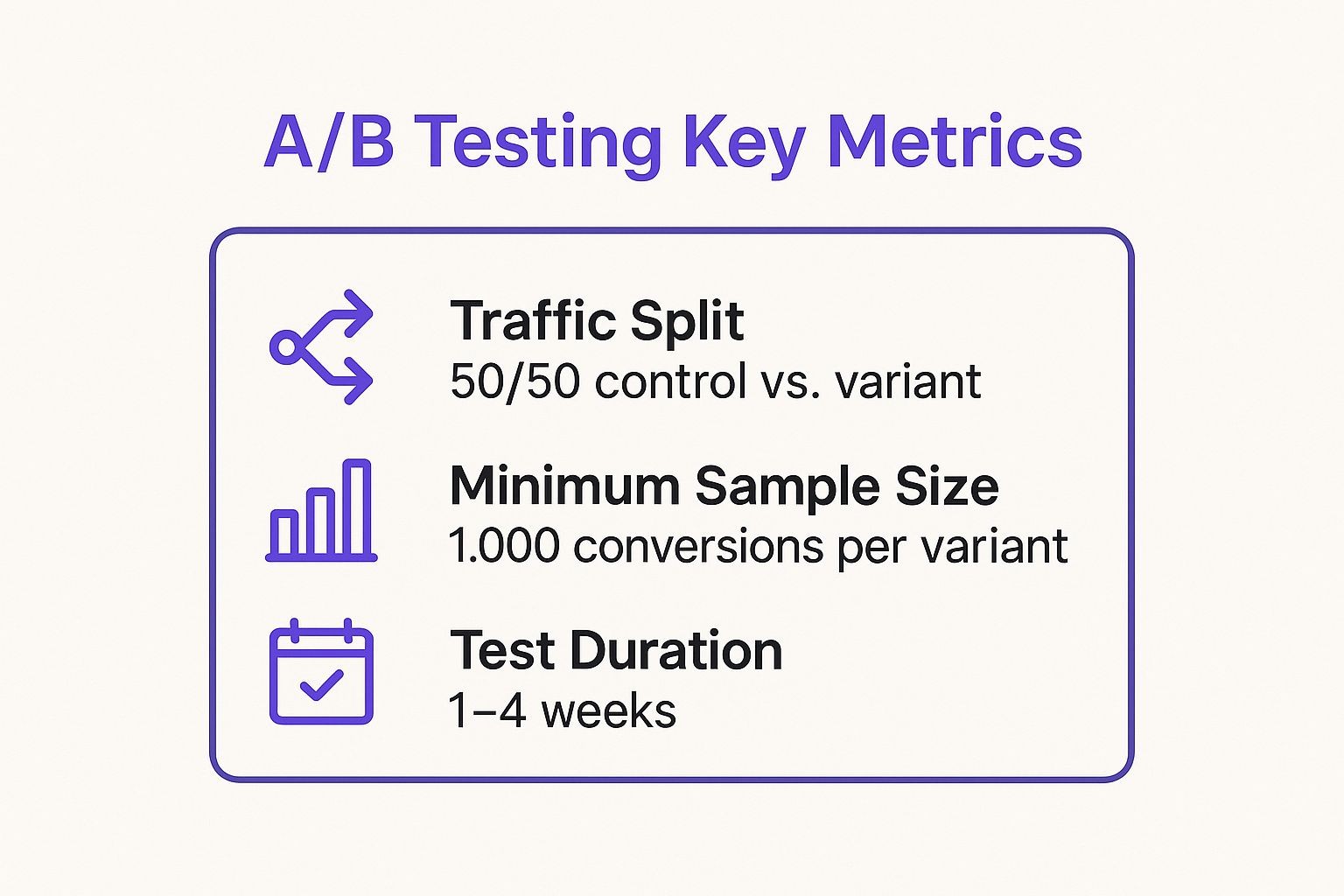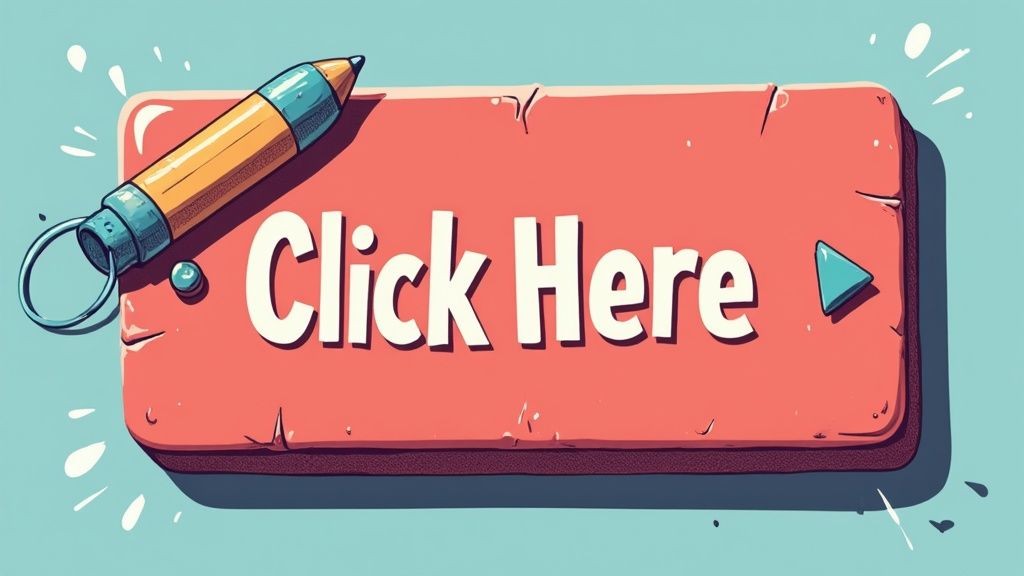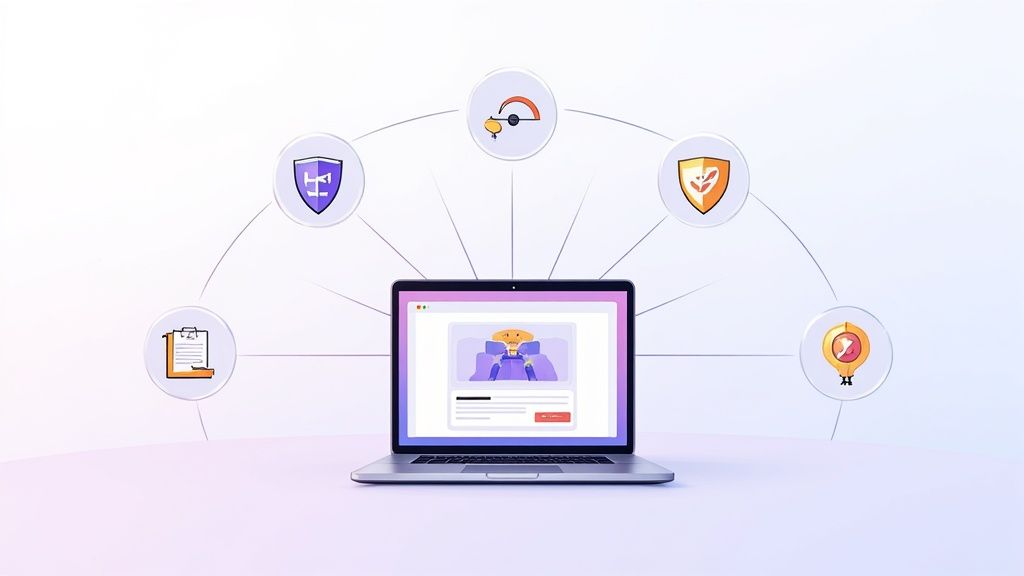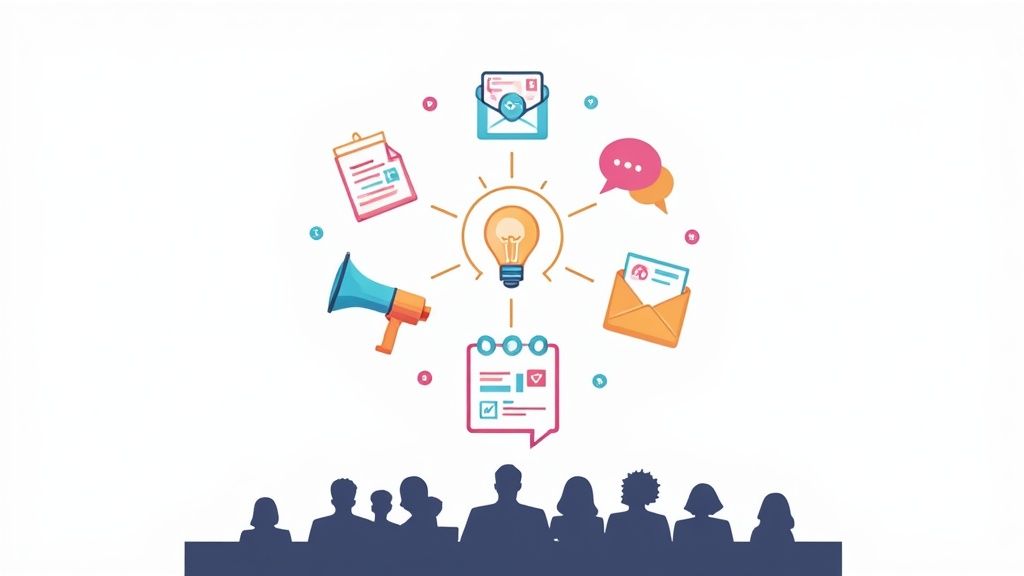Welcome, event marketers! In a world where every click counts, turning a curious visitor into a registered attendee is the ultimate goal. That's where Conversion Rate Optimization (CRO) comes in. It's the systematic process of increasing the percentage of website visitors who take a desired action - in your case, signing up for an event, webinar, or conference. This guide moves beyond generic tips to provide a deep dive into actionable conversion rate optimization best practices specifically tailored for those of you managing event landing pages and registration forms.
We understand the unique challenges you face, from high bounce rates on event pages to abandoned multi-step registration forms. In our experience, small, strategic changes can lead to significant increases in event attendance and engagement. Our service is designed to make event promotion seamless, and this guide will equip you with the knowledge to maximize the effectiveness of every tool at your disposal, including your registration process and promotional assets.
This article is your blueprint for improving performance. We will explore nine proven strategies, from A/B testing workflows and CTA optimization to form design and leveraging trust signals. These insights will help you diagnose friction points in your user journey and implement targeted solutions. By applying these conversion rate optimization best practices, you can stop leaving registrations on the table and start filling your virtual or physical seats more effectively. Let’s begin.
1. A/B Testing and Statistical Significance
A/B testing, also known as split testing, is a foundational conversion rate optimization best practice. It’s a methodical approach to comparing two versions of a webpage, email, or other asset (Version A, the control, and Version B, the variant) to see which one performs better. By showing each version to a different segment of your audience simultaneously, you can use data, not intuition, to make impactful decisions.
For event marketers, this means you can test crucial elements of your landing page. For example, you could test the call-to-action on your "Add to Calendar" button. Does "Save Your Spot" convert better than "Add to Calendar"? An A/B test provides the definitive answer. This process eliminates guesswork and systematically improves the user experience, leading to higher registration rates and event attendance.
How to Implement A/B Testing Effectively
Successful A/B testing relies on a structured process. Before launching a test, form a clear hypothesis. For instance, "Changing the event registration button color from blue to orange will increase clicks because it stands out more against our brand's background." Then, use a platform like Google Optimize, Optimizely, or VWO to split traffic between the two versions.
Here are some key steps to follow:
- Test One Variable at a Time: To know what caused a change in performance, isolate a single element. Test a headline or an image, but not both in the same test.
- Run Tests for Full Business Cycles: Let your test run for at least one to two full weeks to account for fluctuations in user behavior on different days.
- Wait for Statistical Significance: Don’t end a test prematurely. Wait until you reach a statistical significance level of 95% or higher to be confident that the results are not due to random chance.
The infographic below highlights the essential metrics for setting up a reliable A/B test.

These metrics provide a framework for ensuring your test results are valid and actionable. Sticking to these guidelines prevents making decisions based on insufficient or skewed data, which is a common pitfall in CRO. By structuring your experiments with these parameters, you build a reliable foundation for iterative improvement.
2. Strategic Call-to-Action (CTA) Optimization
A call-to-action (CTA) is the gateway to conversion, guiding users to take the next step. Strategic CTA optimization involves carefully designing, placing, and wording these critical buttons or links to maximize user engagement. This practice focuses on making CTAs highly visible, compelling, and perfectly aligned with the user’s intent, turning passive visitors into active participants.
For event marketers, the CTA is often the final hurdle between a potential attendee and a confirmed registration. A simple change in wording or color can dramatically impact sign-ups. For instance, Netflix's "Join Free for a Month" CTA is a masterclass in this, as it emphasizes a low-risk benefit rather than a long-term subscription commitment. Applying this logic to events means your CTA should clearly communicate value and ease, making the decision to register feel effortless.
How to Implement CTA Optimization Effectively
Effective CTA optimization is a blend of psychology, design, and continuous testing. The goal is to remove friction and create a clear, persuasive path for the user. Before making changes, understand your audience and the specific action you want them to take. A well-crafted CTA is not just a button; it's the culmination of your page’s messaging.
Here are some key steps to follow:
- Use Action-Oriented and Specific Language: Vague CTAs like "Submit" create uncertainty. Instead, use specific, benefit-driven text. "Get My Free Event Guide" is far more compelling than "Download." This is a core tenet of modern conversion rate optimization best practices.
- Design for Visibility: Your CTA should stand out visually. Use a contrasting color that aligns with your brand palette but draws the eye. Ensure the button is large enough to be easily clickable, especially on mobile devices (a minimum size of 44x44 pixels is recommended).
- Test First-Person vs. Second-Person Copy: Frame the action from the user's perspective. Unbounce famously found that changing a CTA from "Start your free 30 day trial" to "Start my free 30 day trial" increased clicks by 90%. Test this to see what resonates with your audience.
The image below illustrates how visual hierarchy and compelling copy come together to create a CTA that converts.

These principles ensure your CTA does more than just exist on the page; it actively works to drive conversions. By focusing on clarity, value, and visual prominence, you can significantly improve the performance of your event landing pages and registration forms. This strategic approach transforms the CTA from a simple design element into a powerful conversion tool.
3. Landing Page Load Speed Optimization
Landing page load speed is a critical, yet often overlooked, conversion rate optimization best practice. It measures the time it takes for all content on your event page to become visible and interactive for a user. In an era of instant gratification, even a one-second delay can lead to a significant drop in conversions, as impatient visitors will simply leave before your registration form ever loads.
For event marketers, a slow landing page means potential attendees abandon the page out of frustration, directly impacting your sign-ups. Major companies have proven the value of speed: Walmart saw a 2% increase in conversions for every one-second improvement in load time, while Pinterest boosted sign-ups by 15% after reducing wait times by 40%. Optimizing your page speed ensures a smooth user experience, reduces bounce rates, and maximizes the number of people who see your call-to-action.
How to Implement Page Speed Optimization Effectively
Improving your page speed involves a series of technical adjustments aimed at making your website lighter and faster. Before making changes, you should first establish a baseline by testing your current event landing page with a tool like Google PageSpeed Insights, which will also provide specific recommendations.
Here are some key steps to follow:
- Optimize Your Images: Large image files are one of the biggest culprits of slow pages. Compress your images and use modern formats like WebP, which offers superior compression without sacrificing quality.
- Implement Lazy Loading: This technique defers the loading of non-critical images and content until the user scrolls down to them. This allows the essential, above-the-fold content, like your event title and registration button, to load almost instantly.
- Minimize Code and HTTP Requests: Combine multiple CSS and JavaScript files into single files to reduce the number of requests a browser has to make. You can also "minify" this code by removing unnecessary characters (like spaces and comments) to shrink the file size.
These tactics form the foundation of a high-performing event landing page that keeps users engaged. By prioritizing a fast and seamless experience, you ensure that your compelling event details and clear calls-to-action are actually seen, paving the way for higher conversion rates.
4. Social Proof and Trust Signal Integration
Social proof is a core psychological principle in marketing and one of the most effective conversion rate optimization best practices. It operates on the idea that people conform to the actions of others under the assumption that those actions reflect correct behavior. By strategically integrating testimonials, user counts, client logos, and security badges, you reduce visitor anxiety and build confidence, directly influencing their decision to convert.
For event marketers, this means showcasing the popularity and credibility of your event. Displaying how many people have already registered or highlighting positive feedback from past attendees can create a sense of FOMO (fear of missing out) and validate the event's value. This method moves beyond simply describing your event; it shows potential attendees that their peers have already found it worthwhile, making the decision to register much easier.
How to Implement Social Proof and Trust Signals Effectively
A successful social proof strategy involves more than just adding a random testimonial to your page. It requires placing the right signals at the right moments in the user journey. Your hypothesis might be, "Adding logos of well-known past attendees below the registration form will increase sign-ups by boosting the event's credibility."
Here are some key steps to follow:
- Use Specific and Authentic Testimonials: Instead of generic praise like "Great event!", use detailed quotes that highlight specific benefits. Including the attendee's name, title, and photo adds a powerful layer of authenticity.
- Showcase Real-Time Activity: Tools that display recent registrations or "people are viewing this event right now" notifications create urgency and social validation. This is particularly effective for time-sensitive events like webinars.
- Position Signals Near Conversion Points: Place trust signals like security badges, privacy policy links, and impressive registration numbers directly next to your call-to-action buttons and forms to overcome last-minute hesitation.
Leveraging social proof is also a cornerstone of effective event promotion on social media platforms. By encouraging user-generated content and sharing attendee excitement, you can amplify your event’s reach and credibility. For a deeper dive into this, you can learn more about how to use social media for event marketing. Integrating these trust-building elements systematically will lead to measurable improvements in your registration rates.
5. Mobile-First Responsive Design
Mobile-first design is a crucial conversion rate optimization best practice that prioritizes the mobile user experience from the very beginning of the design process. With a significant portion of web traffic originating from smartphones, this approach starts with the smallest screen and progressively enhances the experience for larger devices like tablets and desktops. This ensures your event pages are not just usable, but optimized for conversions on the devices your audience uses most.
For event marketers, a mobile-first strategy means designing your registration flow for on-the-go users. Imagine a potential attendee seeing your event on social media while commuting. They need a seamless, quick way to register or add the event to their calendar. A clunky, hard-to-navigate mobile site creates friction and leads to lost conversions. Prioritizing mobile ensures the path to registration is smooth, fast, and intuitive, directly boosting sign-ups.
How to Implement Mobile-First Design Effectively
Adopting a mobile-first mindset requires a strategic shift in how you build your landing pages. Instead of scaling a complex desktop design down, you build up from a focused mobile core. The goal is to deliver essential content and calls-to-action efficiently, acknowledging that mobile users often have less time and patience.
Here are some key steps to follow:
- Design for Thumb Navigation: Place key interactive elements like registration buttons and "Add to Calendar" links within the natural reach of a user's thumb. This improves usability and reduces effort.
- Simplify Forms and Inputs: Use mobile-specific keyboards (e.g., numeric for phone numbers) and keep forms as short as possible. Break longer forms into multiple steps to avoid overwhelming users.
- Use Large, Tappable Buttons: Ensure all buttons and clickable links are large enough to be easily tapped without accidental clicks. A minimum target size of 44x44 pixels is a widely accepted standard.
- Optimize for Speed: Compress images and streamline code to ensure your page loads quickly on mobile networks. Slow load times are a major cause of user drop-off and a key factor in mobile conversion rates.
- Test on Real Devices: While browser simulators are helpful, nothing beats testing your event page on actual iOS and Android devices to identify real-world usability issues.
6. Form Optimization and Friction Reduction
Form optimization is a critical conversion rate optimization best practice focused on making your forms as easy and painless to complete as possible. It involves reducing friction by streamlining fields, improving user experience, and eliminating any unnecessary steps that could lead to abandonment. Every field you ask a user to fill out is a potential point of friction, and minimizing that friction is key to maximizing conversions.
For event marketers, the registration form is often the final hurdle between a potential attendee and a confirmed participant. A long, confusing, or clunky form can undo all your hard work in driving traffic to the page. For example, by removing a single "Company Name" field, Expedia increased annual profits by $12 million. This demonstrates how even minor adjustments can have a massive impact on user behavior and your bottom line.
How to Implement Form Optimization Effectively
A well-optimized form feels intuitive and effortless for the user. The goal is to ask for only the most essential information required for the conversion, whether that’s an event registration or a newsletter signup. Start by mapping out the user’s journey and questioning the necessity of every single field.
Here are some key steps to follow:
- Remove Non-Essential Fields: Scrutinize every field. Is "phone number" absolutely necessary for a webinar registration? If not, remove it. Clearly mark any fields that are truly optional.
- Use a Single-Column Layout: Single-column forms are easier to scan and complete, especially on mobile devices. This linear path helps users maintain focus and move through the form more quickly.
- Implement Smart Form Features: Use features like address auto-complete and inline validation, which provides real-time feedback on errors before the user hits submit. This prevents frustration and reduces submission failures.
- Offer Social Login Options: Allow users to register using their Google or LinkedIn accounts. This significantly reduces the effort required to sign up, boosting completion rates.
Optimizing your form is a direct investment in improving the user experience at the most crucial conversion point. For more inspiration on designing high-converting forms, you can find several effective layouts and strategies in these registration form examples. By applying these principles, you can systematically reduce abandonment and increase event sign-ups.
7. Personalization and Dynamic Content
Personalization is a powerful conversion rate optimization best practice that involves tailoring website content and experiences to individual users. Instead of a one-size-fits-all approach, you can deliver dynamic content based on user behavior, location, referral source, or past interactions. This creates a more relevant and engaging journey that speaks directly to the user's needs, significantly boosting the likelihood of conversion.
For event marketers, this means you can show different event details or promotions to different audience segments. For example, a visitor from a partner’s website could see a co-branded landing page, while a returning visitor might see a "Welcome Back!" message with a special discount for their next event registration. By making the experience feel unique and personal, you build a stronger connection with your audience, which drives higher engagement and sign-ups.
How to Implement Personalization Effectively
Effective personalization starts with data and a clear strategy. Your goal is to use what you know about a visitor to provide them with a more valuable experience. Start by identifying key user segments and then create tailored content for them. Platforms like Optimizely or Dynamic Yield can help you implement these changes without needing heavy developer resources.
Here are some key steps to follow:
- Segment Your Audience: Begin with simple segmentation. You can create different experiences for first-time visitors versus returning users, or for visitors from different geographic locations.
- Personalize Key Elements: Focus on high-impact areas first. Test personalized headlines, calls-to-action (CTAs), or event recommendations. A user from New York, for instance, could see a list of upcoming local events.
- Use First-Party Data: Leverage data you collect directly, such as past event attendance or interests, to inform your personalization strategy. Always respect user privacy and be transparent about data usage.
- Measure the Impact: Just like any other CRO effort, test your personalized experiences against a control version. This will help you quantify the uplift and prove the ROI of your personalization efforts.
8. Urgency and Scarcity Psychology
Leveraging urgency and scarcity is a powerful conversion rate optimization best practice rooted in human psychology. These tactics motivate potential attendees to act immediately by tapping into the fear of missing out (FOMO). By signaling that an opportunity is limited by time (urgency) or quantity (scarcity), you encourage users to stop procrastinating and complete the desired action, such as registering for an event or purchasing a ticket.
For event marketers, this means creating a compelling reason for your audience to commit now rather than later. For example, using a countdown timer for an early-bird ticket special creates a clear deadline. Similarly, displaying a message like "Only 50 VIP tickets remaining" introduces scarcity. This approach transforms passive interest into active conversion, directly boosting registration numbers and securing attendee commitments well before your event date.
How to Implement Urgency and Scarcity Effectively
Successful implementation requires being both strategic and authentic. Your claims must be genuine to build and maintain trust with your audience. Start by identifying real limitations associated with your event, such as a limited number of seats, a true deadline for a discount, or exclusive bonus content for the first 100 registrants.
Here are some key steps to follow:
- Be Truthful and Verifiable: Never use false scarcity. If you say only 20 spots are left, it must be true. Losing audience trust will harm your brand far more than any short-term conversion gain.
- Use Countdown Timers: Visually represent the passage of time on your landing page for special offers or registration deadlines. This is a constant, powerful reminder of the approaching deadline.
- Highlight Limited Availability: Clearly display messages like "Limited seating available" or "Only 15 spots left for the workshop." This is particularly effective for exclusive or high-demand events.
- Combine with a Clear Value Proposition: Urgency works best when the value is obvious. Pair your scarcity message with a strong benefit, such as "Register before Friday to save 25% and get our exclusive pre-event guide."
These tactics are fundamental to driving timely action. By creating a sense of controlled urgency, you can significantly shorten the decision-making cycle for potential attendees, turning hesitation into immediate registration and making it one of the most effective conversion rate optimization best practices in an event marketer's toolkit.
9. Value Proposition Clarity and Messaging
Your value proposition is the core promise you make to your audience. It's a clear, concise statement that explains what benefit you provide, for whom, and how you do it uniquely well. Strong value proposition clarity and messaging are essential conversion rate optimization best practices because they answer the visitor’s most critical question: “What’s in it for me?” If they can’t understand the value instantly, they will leave.
For event marketers, this means clearly articulating why someone should sacrifice their time to attend your webinar, conference, or launch. Is it for exclusive networking opportunities, to learn a specific skill, or to get a sneak peek at a new product? A compelling value proposition like "Master AI-driven marketing in one afternoon" is far more effective than a vague title like "Marketing Innovations Webinar," as it immediately communicates a tangible outcome.
How to Implement Value Proposition Clarity Effectively
Developing a powerful value proposition involves more than just clever copywriting; it requires a deep understanding of your audience's pain points and motivations. Your goal is to align what your event offers with what your target attendee truly needs. Start by answering: What specific problem does my event solve for my audience?
Here are some key steps to follow:
- Lead with the Outcome: Focus your messaging on the benefit the attendee will receive, not the features of the event. Instead of "Featuring three keynote speakers," try "Learn from three industry titans who tripled their revenue."
- Be Specific and Quantifiable: Use numbers to make your claims more believable and impactful. "Join over 2,000 marketing professionals" adds social proof and credibility.
- Address Primary Objections: Directly tackle potential hesitations. If your event is virtual, you could message, "Can't make it live? All registrants get lifetime access to the recordings."
- Use Your Customer’s Language: Avoid internal jargon. Analyze customer reviews, surveys, and testimonials to understand how your audience describes their challenges and desired outcomes, and then mirror that language.
Making your value proposition the most prominent element on your landing page ensures it's the first thing visitors see. This single practice can dramatically improve comprehension and motivate visitors to take the next step, whether that's registering, downloading a brochure, or adding the event to their calendar.
Conversion Optimization Best Practices Comparison
| Item | Implementation Complexity 🔄 | Resource Requirements ⚡ | Expected Outcomes 📊 | Ideal Use Cases 💡 | Key Advantages ⭐ |
|---|---|---|---|---|---|
| A/B Testing and Statistical Significance | Medium to High - requires setup and statistical rigor | High - needs sufficient traffic and analytics tools | Reliable data-driven insights and conversion improvements | Testing specific changes in marketing assets with enough traffic | Minimizes risk, continuous optimization, deep user behavior insights |
| Strategic Call-to-Action (CTA) Optimization | Low to Medium - mostly design and copy changes | Low - manageable with basic design and marketing resources | Quick wins in conversion rate improvement | Enhancing user actions on pages with CTAs | Direct impact, easy to iterate, cost-effective |
| Landing Page Load Speed Optimization | Medium to High - technical knowledge required | Medium to High - needs dev resources and tools | Better user experience, lower bounce rates, SEO boost | Sites with heavy traffic or slow load times | Improves UX, reduces bounce, immediate impact |
| Social Proof and Trust Signal Integration | Low to Medium - content and UI integration | Low to Medium - requires authentic social content | Increased trust and conversions | New visitor trust building and reducing purchase anxiety | Builds credibility, leverages psychological triggers |
| Mobile-First Responsive Design | Medium to High - design and dev effort | Medium to High - requires testing and development | Enhanced mobile UX, improved mobile conversion rates | Websites with majority mobile users | Captures mobile audience, improves SEO |
| Form Optimization and Friction Reduction | Medium - UX and technical changes | Medium - requires design, development, and analytics | Reduced abandonment, higher form completions | Lead generation and sign-up forms | Reduces friction, improves form completion rates |
| Personalization and Dynamic Content | High - complex data management and tech | High - needs data infrastructure and content management | Higher engagement and targeted conversion uplift | Personalized marketing and user experience | Drives relevance, better ROI, user insights |
| Urgency and Scarcity Psychology | Low to Medium - messaging and UI changes | Low to Medium - primarily content and minor dev changes | Short-term conversion boosts | Time-sensitive offers, promotions | Creates motivation, reduces procrastination |
| Value Proposition Clarity and Messaging | Medium - requires research and copywriting | Low to Medium - content creation and design | Improved clarity, higher qualified conversions | All marketing materials and landing pages | Clarifies value quickly, reduces confusion |
Putting It All Together for Higher Event Turnout
We've explored an extensive toolkit of nine powerful conversion rate optimization best practices, each a critical lever for turning passive interest into active event participation. From the disciplined, data-driven world of A/B testing to the psychological nuances of urgency and scarcity, the path to a higher event turnout is paved with intentional, user-centric design and strategic marketing. Mastering these principles is not about finding a single magic bullet; it's about building a comprehensive, continuous system of improvement.
This journey transforms your role from a simple event promoter into that of a conversion architect. You are no longer just announcing an event; you are meticulously crafting the user’s journey, removing every point of friction, and reinforcing the value of attendance at every turn. Think of each practice as an interconnected gear in a larger machine. A lightning-fast landing page (Practice #3) is powerful, but its impact multiplies when combined with compelling social proof (Practice #4) and a frictionless registration form (Practice #6).
Your CRO Implementation Roadmap
Getting started can feel overwhelming, but progress is made through incremental, focused action. Don't try to overhaul everything at once. Instead, adopt a phased approach to integrate these conversion rate optimization best practices into your workflow.
Here is a practical, step-by-step plan to begin your CRO journey today:
- Start with a Diagnostic: Before you change anything, understand your baseline. Use analytics tools to identify your biggest drop-off points. Is it the registration form? Is your mobile bounce rate unusually high? Data will point you to the most critical area for immediate attention.
- Target the Low-Hanging Fruit: Begin with the changes that require the least effort for the highest potential impact. Optimizing your CTA button text (Practice #2) or clarifying your value proposition (Practice #9) are often quick wins that can yield immediate results.
- Commit to a Testing Cadence: Make A/B testing (Practice #1) a non-negotiable part of your marketing routine. Even one test per month builds momentum and generates invaluable insights about your specific audience. What works for one event's audience may not work for another.
- Layer on the Enhancements: Once you have a solid foundation, begin integrating more complex strategies. Implement personalization and dynamic content (Practice #7) to create a more relevant experience, and strategically weave in trust signals to build credibility.
The Long-Term Value of a Conversion-Focused Mindset
Adopting these CRO principles does more than just boost registration numbers for your next event; it fundamentally improves the attendee experience from the very first touchpoint. A seamless, intuitive, and trustworthy registration process sets a positive tone for the event itself, signaling professionalism and a commitment to attendee satisfaction.
Furthermore, this focus on optimization builds a powerful feedback loop. With each test and iteration, you learn more about your audience's motivations, hesitations, and preferences. This deep understanding becomes your greatest competitive advantage, allowing you to create more compelling event concepts, write more resonant copy, and build a loyal community that eagerly awaits your next announcement.
At its core, conversion rate optimization is an exercise in empathy. It’s about putting yourself in your potential attendee’s shoes and making their journey as effortless and rewarding as possible. By embracing this mindset, you’re not just chasing metrics; you’re building stronger relationships and ensuring every event you host reaches its maximum potential.
Ready to put these principles into action with a tool built for high-conversion event marketing? Add to Calendar PRO integrates seamlessly into your CRO strategy with SEO-optimized landing pages, customizable RSVP forms, and the most reliable Add to Calendar buttons available. Start turning more visitors into confirmed attendees by exploring our features at Add to Calendar PRO today.



